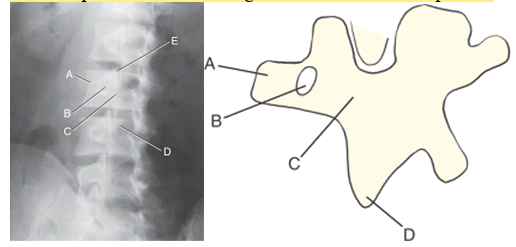A) a teardrop burst fracture.
B) a chance fracture.
C) a compression fracture.
D) spondylolysis.
Correct Answer

verified
C
Correct Answer
verified
Multiple Choice
Radiographs of oblique projections of the SI joints do not clearly demonstrate the inferior/distal aspect of the joints.What can the technologist do to better demonstrate this region?
A) Increase rotation of the pelvis.
B) Initiate exposure upon expiration.
C) Angle CR 15° to 20° cephalad.
D) Perform positions erect.
Correct Answer

verified
Correct Answer
verified
Multiple Choice
A radiograph of an AP axial coccyx reveals that the symphysis pubis is superimposed over the distal end of the coccyx.Which of the following modifications will correct this problem during the repeat exposure?
A) Decrease the CR angulation.
B) Increase the CR angulation.
C) Slightly oblique the patient.
D) Ask the patient to empty her bladder.
Correct Answer

verified
Correct Answer
verified
Multiple Choice
A patient comes to radiology for a follow-up study of the lumbar spine.The patient had a spinal fusion performed at the L3-4 level 4 months earlier.Which of the following would best demonstrate the degree of movement at the fusion site?
A) Lateral hyperextension and hyperflexion projections
B) Ferguson method
C) AP and lateral erect projections
D) Right and left 45° oblique projections
Correct Answer

verified
Correct Answer
verified
Multiple Choice
Why should the hips and knees be flexed for an anteroposterior (AP) projection of the lumbar spine?
A) For patient comfort
B) To reduce the lumbar curvature
C) To demonstrate any possible spondylolisthesis
D) Both A and B
Correct Answer

verified
D
Correct Answer
verified
Multiple Choice
A key advantage of a posteroanterior (PA) projection taken during a pediatric scoliosis study as compared with the AP projection is that it reduces:
A) breast and thyroid dose by 90%.
B) female ovarian dose by 25% to 30%.
C) breast dose by 15% to 20%.
D) breast and thyroid dose by 150%.
Correct Answer

verified
Correct Answer
verified
True/False
AEC (automatic exposure control)should not be used for an L5-S1 lateral or a lateral sacrum and coccyx.
Correct Answer

verified
Correct Answer
verified
Multiple Choice
Which of the following structures is located at the level of the ASIS?
A) S1-2
B) Tip of coccyx
C) Promontory of sacrum
D) L4-5
Correct Answer

verified
Correct Answer
verified
Multiple Choice
A radiograph of a lateral projection of the lumbar spine reveals that the mid- to lower-intervertebral joint spaces are not open.The patient's waist was supported.Which of the following modifications will help open these joint spaces during the repeat exposure?
A) Increase the SID for less divergence of the x-ray beam.
B) Decrease waist support and/or angle the CR 5° to 8° cephalad.
C) Have the patient hold her breath on a deeper inspiration to expand the thorax and straighten the spine.
D) Increase waist support and/or angle CR 5° to 8° caudal.
Correct Answer

verified
D
Correct Answer
verified
Multiple Choice
The zygapophyseal joints of the upper lumbar vertebrae are ____ in relationship to the midsagittal plane.
A) 30°
B) 50°
C) 45°
D) 90°
Correct Answer

verified
Correct Answer
verified
Multiple Choice
The small section of bone found between the superior and inferior articular processes of the lumbar spine is termed:
A) pillar.
B) transverse processes.
C) articular facets.
D) pars interarticularis.
Correct Answer

verified
Correct Answer
verified
Multiple Choice
A destructive type of lesion with irregular margins and increased density is an indication of possible:
A) osteoblastic type of metastases.
B) osteolytic of type metastases.
C) spondylolisthesis.
D) spondylolysis.
Correct Answer

verified
Correct Answer
verified
True/False
A female is more likely to suffer a fracture of the coccyx due to a backward,sitting type of fall than a male.
Correct Answer

verified
Correct Answer
verified
Multiple Choice
Which aspect of the Scottie dog is the inferior articular process?

A) A
B) B
C) C
D) D
Correct Answer

verified
Correct Answer
verified
True/False
If the waist is supported properly,an average-size patient does not require any CR angulation for the lateral lumbar spine projection.
Correct Answer

verified
Correct Answer
verified
True/False
Carefully placed gonadal shielding must always be used on female patients for the AP lumbar spine projection.
Correct Answer

verified
Correct Answer
verified
Multiple Choice
Which of the following is a condition of unknown cause in which calcification of bony ridges between vertebrae occurs,creating a lack of mobility with a "bamboo" appearance?
A) Scheuermann disease
B) Ankylosing spondylitis
C) Spondylolisthesis
D) Osteoblastic type of metastases
Correct Answer

verified
Correct Answer
verified
Multiple Choice
The radiographic appearance on an oblique lumbar spine in which the neck of the Scottie dog appears broken suggests the presence of:
A) spondylolisthesis.
B) spina bifida.
C) compression fracture.
D) spondylolysis.
Correct Answer

verified
Correct Answer
verified
True/False
Bone densitometry produces very little skin dose to the patient.
Correct Answer

verified
Correct Answer
verified
Multiple Choice
The intervertebral joints in the lumbar spine are classified as:
A) synovial/diarthrodial.
B) fibrous/synarthrodial.
C) cartilaginous/amphiarthrodial.
D) fibrous/amphiarthrodial.
Correct Answer

verified
Correct Answer
verified
Showing 1 - 20 of 75
Related Exams